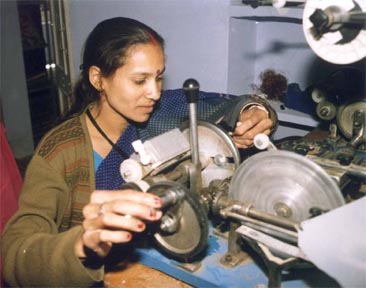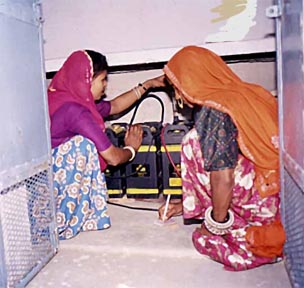Dec 25, 2025
Dec 25, 2025
by Shruti Gupta
 Gulab Devi (45) of Harmara Village in Rajasthan's Ajmer district comes across as the quintessential rural woman from Rajasthan. Dressed in the traditional ghagra-choli (long skirt and blouse), Gulab is the sole bread-earner for her four children and her ailing husband who hasn't had a job in the 24 years of their marriage.
Gulab Devi (45) of Harmara Village in Rajasthan's Ajmer district comes across as the quintessential rural woman from Rajasthan. Dressed in the traditional ghagra-choli (long skirt and blouse), Gulab is the sole bread-earner for her four children and her ailing husband who hasn't had a job in the 24 years of their marriage.
Gulab is completely illiterate. Ask her what she does for a living, and she'll tell you she makes electronic circuits and chargers for solar lighting panels. And before you start wondering whether you heard her wrong, she'll tell you that she also installs and maintains hand pumps, water tanks and pipelines. Not only is she running her household comfortably with her salary from this work, she is also one of the most respected members of her community.
 Gulab is one of the many "Barefoot Solar Engineers (BSEs)" working across eight Indian states (Rajasthan, Bihar, Andhra Pradesh, Orissa, Uttaranchal, Jammu and Kashmir, Assam and Sikkim) to establish solar energy systems in areas where electricity supply is either non-existent or highly erratic. A majority of these engineers, mostly women, are illiterate like Gulab or semi-literate at best. But they talk of transformers, coils and condensers like other women would talk of cooking and sewing. Their dexterity with spanners and screwdrivers is impressive, to say the least.
Gulab is one of the many "Barefoot Solar Engineers (BSEs)" working across eight Indian states (Rajasthan, Bihar, Andhra Pradesh, Orissa, Uttaranchal, Jammu and Kashmir, Assam and Sikkim) to establish solar energy systems in areas where electricity supply is either non-existent or highly erratic. A majority of these engineers, mostly women, are illiterate like Gulab or semi-literate at best. But they talk of transformers, coils and condensers like other women would talk of cooking and sewing. Their dexterity with spanners and screwdrivers is impressive, to say the least.
The Ministry of Non-Conventional Energy Sources, the European Commission and the United Nations Development Program (UNDP) support the Barefoot Solar Engineering program. It is implemented by the Barefoot College, also known as the Social Work Research Centre or SWRC, an NGO based in Tilonia, Rajasthan. Set up by noted social worker Bunker Roy, the Barefoot College addresses community problems by building upon people's skills and placing the solutions to their problems in their own hands.
"The focus is on sustainable use of solar energy. People should be able to do their own solar engineering according to their own needs," says Bhagwat Nandan Sewda, the focal person of the BSE program. Affectionately referred to as 'guruji', Sewda runs solar training programs for people from all over the country.
Kausalya of Buharu village in Tilonia, presents another heartening story. All of 19, Kausalya is adept at fixing and maintaining solar energy systems. What she is also good at is local governance. She used to attend the village night school when Barefoot College introduced the Bal Sansad, or the Children's Parliament. The concepts of local, state and central governments were explained to school students, who were encouraged to compete for the posts of 'MLAs' (legislators) for the Bal Sansad. Prompted by other girls who were too timid to take on male students, Kausalya filed her nomination. She was the token candidate of the entire female electorate, and bagged the post from her school.
Then followed the prime ministerial contest in which all the 'MLAs' from over 50 schools in Tilonia contested. Once again she got all the girl votes, while some infighting among others got her a substantial chunk of the boy votes. Kausalya became the prime minister of the Bal Sansad at the age of 13. In three years of heading the Sansad, Kausalya's 'cabinet' solved a host of problems - from the lack of electricity in one village school, to the local sarpanch trying to usurp the land of another. At the end of her term, Kausalya's parents discontinued her education, and she took up solar training at SWRC.
Life took another turn when she came of age and was packed off to her husband's home (she had been married when just a few years old) in Jaipur's Pandwa village. Here too, Kausalya worked on the infrastructure of Pandwa, including solar lights and a new water pipeline. Unhappy with her 'activism' to begin with, her husband and parents-in-law gradually came to admire her efforts. "My husband will never say it, but I know he's very proud of me," says Kausalya. "Now he asks me to maintain his accounts for him!"
Barefoot's project partners are encouraged by the response to the program, which has received the Stockholm Challenge Award for Environment in 2002. "The project has empowered women. Illiterate and semi-literate women are operating and repairing energy systems. It has also freed them from the drudgery of searching for fuel-wood and reduced the health hazards of burning wood-fires," says Maurice Dewulf, Deputy Senior Resident Representative, UNDP. "The project has demonstrated how solar energy provides a solution not just for cooking and lighting but also for education, agriculture, health, and income-generation."
Another case in point is 26-year-old Ritma Bharti from Bihar's West Champaran district. Her village Bahurva had no provision for electricity; sunset meant the end of all economic activity for the day, including her husband's shop. When she heard about the solar training workshop in Tilonia, she told her husband she wanted to go for the training. Her husband agreed, although her mother-in-law threw a fit. But Ritma was adamant and took off for the six-month workshop, her two-year-old in tow.
By the end of the workshop, she had prepared 80 solar lanterns to carry back home. She installed these in 40 schools in the area, and looked after their maintenance as well. Ritma has gradually trained many fellow villagers in the operation and repair of these lanterns, and more than 750 lanterns are now being used to run schools, irrigation facilities, shops and medical centers late into the evening.
What Ritma is personally happiest about is that women's self-help groups can use these lanterns to meet after sunset, as their daytime is packed with domestic chores. Each woman saves a fistful of foodgrain everyday. At the end of the month, all the foodgrain is sold, and the money carefully put away for cheap lending to any member in times of need. This banking system has only been possible because of the nightly meetings of the group. "I now look back at my childhood when I always dreamt of doing something big for my society," Ritma says. "My mother used to laugh at me. Today my family, my neighbors, and even the village elders respect me and value my contributions. It feels wonderful."
Similar stories are unfolding in the north-eastern parts of the country. Pretty, cheerful and enthusiastic Devi from Sikkim has been a solar engineer since the age of 15. She has helped establish solar panels in four districts of Sikkim, covering even the most remote areas. People are now using solar energy for heating, water supply, and running fax and STD systems. Devi looks back on the earlier days and laughs. "When I first talked of solar training, the boys in the neighborhood mocked me and said I would look ridiculous climbing poles to set up the panels. At that time I was too timid to retort. Now my work speaks for itself, and even the boys come to me for advice on various matters. I have even started joining them in their football games!"
The Barefoot campus itself, spread over an 80,000 square feet area is completely powered by solar energy. But the most powerful impact of the program lies in the stories of Gulab, Kausalya, Ritma and many others. Also, of using energy as a key input to better life and sustainable livelihood.
19-Jan-2003
More by : Shruti Gupta

|
excellent work.iam P. Harish reddy studying b-tech 1st year in rajamahendri institute of engineering and technology in electronics and communication group(E.C.E).iam also interested to improve utilization of this solar energy even for a common man and save the national economy and also save the non-renewable sources we are using today so please guide me in this regard .i would be always thankful for u if u guide me...i also want to take up my project work in my 4rth year at your college guidance ...........thank you |